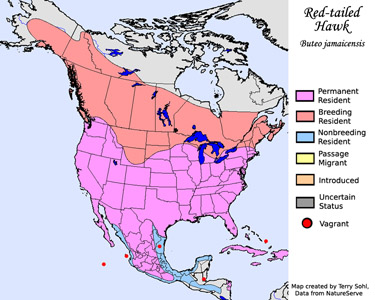
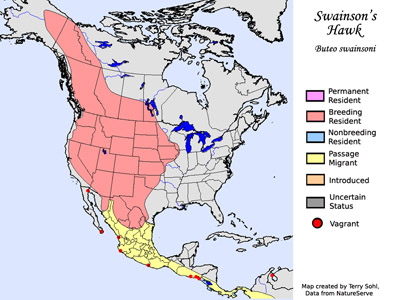
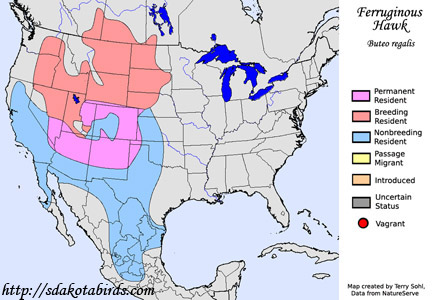
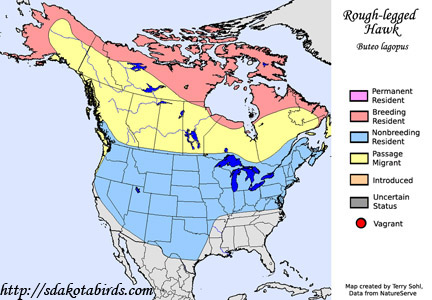

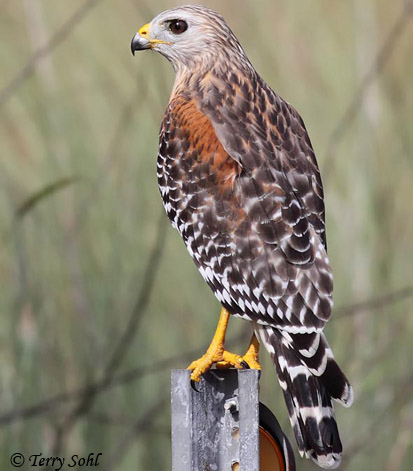
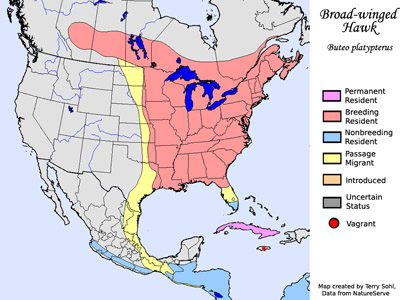
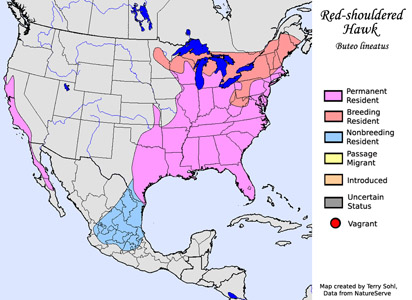
| Return to Main Page | Dakota Birder Blog | Follow @DakotaBirder |
| NOTE: The "Buteo" hawks below can be a significant identification challenge. Size and body shape are similar for many of these species, and while plumage differences are usually readily seen, differentiating species is complicated by the fact that most of these species have different color morphs, as well as different plumage characteristics between adult and juvenile birds. To identify Buteo species, focus on the identification tips provided below, as well as the provided seasonality and range maps across North America. Learning to identify Red-tailed Hawks and using them as a bird from which to compare other species is often a good strategy, particularly since Red-tailed Hawks tend to be the most widely spread and common of the Buteo species. Note that in addition to the one provided photo provided for each species description below, there are many additional photos at the bottom of the page (photos of different color morphs, as well as juvenile and adult birds). The photos below are not to scale, and thus cannot be used to directly compare size among the different species. Finally, note some of the rarer Buteos that are less commonly found in the U.S. (e.g., White-tailed Hawk, Zone-tailed Hawk, etc.) are not shown below. | ||
| Red-tailed Hawk | Swainson's Hawk | |
| Buteo jamaicensis | Buteo swainsoni | |
|
|
|
|
| Overall: Red-tailed Hawks come in a very wide array of plumage patterns, from very light-colored birds ("Krider's Hawks") to very dark-colored birds ("Harlan's Hawks"). Photos of multiple color morphs, as well as photos of both juvenile and adult birds, are found at the bottom of the page. | Overall: As with Red-tailed Hawks, Swainson's Hawks come in multiple color morphs. A light-colored morph (shown above) is the most common, but there is also a richly colored intermediate morph with substantial rufous coloring, and a dark-colored morph. Photos of multiple color morphs are found at the bottom of the page. | |
| Height: 19-25 inches | Height: 19-22 inches | |
| Wingspan: 46-58 inches | Wingspan: 46-54 inches | |
| Body: Many color morphs have lighter undersides with a "belly band" of spots and streaks (see photo above for example of the belly band). Dark morph birds can be nearly all dark on the underside. A rufous-morph bird has a dark underside with a rufous-colored upper chest. | Body: Variable depending upon color morph. Light morph (shown in photo above) has white underparts with a darker rufous-colored bib on the upper chest. Intermediate morph birds has extensive rufous on lower parts. Dark-morph birds are dark brownish on all of the underbody, some with a hint of very dark rufous tones. Juvenile birds have similar color patterns faithful to the color morph, but typically with substantial streaking and spots instead of solid colors on the underparts. | |
| Wings (underside): Light and intermediate color morphs have an obvious dark leading edge to the wings between the shoulder and wrist (see photo above for example), present on both juvenile and adult birds. Dark morphs have dark coverts with light primary and secondary flight feathers. Adults of all color morphs have a darker trailing edge of the wings (again see photo above) but this is lacking on juvenile birds. | Wings (underside): Overall, all color morphs show a contract between the coverts and the flight feathers. Light-morph birds have distinctive white wing linings with strongly contrasting darker flight feathers, and unique pattern among North American raptors. Intermediate and dark morph birds show some contrast between the wing linings and flight feathers, but wing linings are much darker than light-morph birds. All color morphs have darker trailing edges on flight feathers. | |
| Wings (upperside): Juveniles typically show a pale outer wing that contrasts with a darker inner wing. Otherwise both juvenile and adult birds typically have dark upper wings (both coverts and primary/secondary flight feathers). | Wings (upperside): Dark plumage overall on the upper wings of all color morphs. Juvenile birds similar have dark upper wings, but lighter morph birds in particular often have lighter streaks and spotting. | |
| Tail: The trademark red tail is present on most adult birds. The exception is the dark "Harlan's Hawk", a bird with a light-colored tail that typically lacks reddish tones. Juvenile birds of all color morphs lack the red tail and instead have a finely barred tail of light and dark horizontal streaks. | Tail: Under tail colors are similar across all color morphs, with relatively light-colored tail feathers marked by several fine darker color bands, and a thicker dark band near the trailing edge of the tail. | |
| Other Identification Keys: Broader-winged and more compact than most of the other Buteos on this page. For adult birds the reddish tail is usually a key, while on juveniles the pale outer wing (upperside) and the barred tail are good indications of a young Red-tailed Hawk. | Other Identification Keys: Is often considered one of the more "slim" of the Buteos, but identification by body shape alone is typically not possible. Wings are longer and more slender than the Red-tailed Hawk. | |
| South Dakota Status: Breeds throughout South Dakota, and found in a variety of habitats, from agricultural land, to grassland, to riparian areas and woodland edges. Some birds retreat from South Dakota in the winter, but they are still found statewide (with higher numbers in the southern part of the state). | South Dakota Status: Found as a summer breeding bird throughout the state, although more numerous in western and northern parts of South Dakota. Strongly migratory, with all birds moving to South America for the winter. | |
 |
 |
|
| Ferruginous Hawk | Rough-legged Hawk | |
| Buteo regalis | Buteo lagopus | |
|
|
|
|
| Overall: Ferruginous Hawks are the largest of the Buteos, and well named (Buteo regalis). They have two typical color morphs, a light (shown above) and a dark. Light color morphs are by far the most common. Differences between juvenile and adult birds are somewhat less substantial than for most other Buteos. The term "ferruginous" refers to the warm rusty reddish colors often found on the shoulder and leg feathers of light-morph birds. Photos of multiple color morphs are found at the bottom of the page. | Overall: Two color morphs of Rough-legged Hawks are typically found, a light morph (shown above) and a dark morph that has very dark overall plumage. The term "rough-legged" refers to the fully feathered legs, similar to a Ferruginous Hawk. Photos of multiple color morphs are found at the bottom of the page. | |
| Height: 22-28 inches (Largest of Buteo hawks on this page) | Height: 18-24 inches | |
| Wingspan: 52-60 inches | Wingspan: 46-54 inches | |
| Body: The underside of a light-morph Ferruginous Hawk is typically brilliantly bright white, with very minimal dark spotting. Darker leg feathering (often with rich rufous tones) contrasts with the lighter-colored body. Dark-morph birds are usually a warm, dark-chocolate brown color underneath. Juvenile birds are similar to adults. | Body: The light-morph has a dark belly that contrasts with a lighter (but typically heavily streaked) chest. Unlike most Buteos, plumage patterns are different between males and females, with males showing more streaking on the belly than dark-bellied females. Dark-morph birds are completely dark on the belly and chest. | |
| Wings (underside): Light-morph birds have light wing linings with darker edging and scattered spots, and very light flight feathers with a faint darker spotting on the trailing edge. Dark-morph birds have dark wing linings with a characteristic white crescent at the outer edge, with strongly contrasting white flight feathers that are similar to the light morph. | Wings (underside): One of the most recognizable identification keys for a light-morph Rough-legged Hawk is the dark "wrist" patch at the bend of the wing that contrasts strongly with both the underside of the wing linings and the flight feathers (see photo above). Adult dark-morph birds have dark wing linings and no obvious wrist patch, but juvenile dark-morph birds still typically show some contrast between the wing linings and a darker wrist patch. Both light- and dark-morph birds have very light flight feathers. | |
| Wings (upperside): Darker coverts contrast with lighter-colored flight feathers on both light and dark-morph birds. White on the inner primaries is particularly obvious with a fully spread wing in flight. | Wings (upperside): Dark overall, but light-morph birds may show some subtle lighter spotting. | |
| Tail: Both light and dark morph birds have light-colored upper tails. Light-morph birds have a white rump (upperside of tail) with a darker center, while dark-morph birds have a darker rump that contrasts with the tail. Tails of both color morphs appear to be mostly white on the underside. | Tail: Light-morph birds show an obvious white "rump" on the upperside of the tail that contrasts with a dark tail. Dark-morph birds lack the white rump and have completely dark upper tails. The underside of the tail is light with a thick dark band near the end of the tail. | |
| Other Identification Keys: Ferruginous Hawks have fully feathered legs, all the way down to their feet. They have large, heavy bills, and a commonly referred to identification key is the long "gape" of the bill that extends back to below the rear of the eye. | Other Identification Keys: Rough-legged Hawks have bills and feet that are smaller than other Buteos in relationship to body size. If seen well, bill size alone can be a good indication of a Rough-legged Hawk. Rough-legged Hawks also can perch on finer branches than many Buteos, as you'll often see them perched on thin terminal branches of trees and shrubs. | |
| South Dakota Status: Breeds in western South Dakota, and less commonly in northeastern South Dakota. Despite the map below, they are commonly found in western and central South Dakota in the wintertime, but are more common in the southern part of the state. | South Dakota Status: Strictly a winter visitor to South Dakota. They can be found statewide in the winter, but are much more common in parts of the state. They are often downright abundant in the central part of the state, while scattered and few in the southeastern part of the state. | |
 |
 |
|
| Broad-winged Hawk | Red-shouldered Hawk | |
| Buteo platypterus | Buteo lineatus | |
 |
 |
|
| Overall: The smallest of the Buteos, but still possibly confused with other Buteos on this page. They are most likely to be confused with the Red-shouldered Hawk, another smallish Buteo species. Has both light- and dark-color morphs, but the dark color morph is typically only found in the western part of its range and is quite rare. | Overall: Red-shouldered Hawks lack the more obvious plumage difference of "light" and "dark" morph birds of other Buteo species, but still exhibit considerable variation in plumage. Overall plumage patterns are similar across their range, but California birds exhibit much richer coloration, while some populations in Florida are much paler. The photo above represents the more pale extreme of a Red-shouldered Hawk, particularly the light-colored head. | |
| Height: 13-18 inches (smallest of hawks on this page) | Height: 17-22 inches | |
| Wingspan: 32-38 inches | Wingspan: 32-45 inches | |
| Body: Adults are light below with a dark rufous chest and throat, and similarly colored barring on the belly that becomes less and less extensive going down the belly. First-year juveniles can have nearly all white undersides with little to no darker markings, or have extensive darker spotting. The rare dark-morph birds are completely dark brown on the body. | Body: The underside of a Red-shouldered Hawks typically has a rich rusty brown on the throat and chest, and extensive rusty barring on the belly that increasingly gives way towards more white as you move towards the tail. Florida birds exhibit the same pattern but typically have much more white on the underside. | |
| Wings (underside): Both wing linings and primary feathers are primarily white with some scattered light spotting, but with a very obvious dark brown border at tips of the flight feathers. Juvenile birds are similarly patterned. The rare dark-morph has dark wing linings, with white flight feathers with the same dark brown border. | Wings (underside): Wing linings are typically light-colored with light rusty streaking. The flight feathers are light overall, with fine darker barring and a thicker dark trailing edge. Near the wingtips, Red-shouldered Hawks have a translucent crescent that is diagnostic of birds in flight. | |
| Wings (upperside): Both light- and dark-morph birds have completely brown upperwings. | Wings (upperside): Red shoulders are obvious on perched birds (as shown above), and if a bird in flight is seen from above. Otherwise, upper wings are dark with some light edging on covert feathers. | |
| Tail: An obvious identification key for adult birds is the tail with broad dark and light bands, visible both on the upperside and lowerside of the tail. Juveniles lack the obvious banding, and instead have very fine banding. | Tail: The tail overall has broad dark banding interspersed by finer white banding. Juveniles have a similar black-and-white banding pattern, but with much thinner and more numerous bands. The banding pattern is visible from both above and below. | |
| Other Identification Keys: Broad-winged Hawks often appear to be compact and "chunky", even more so than other Buteo hawks. If seen in flight, Broad-winged Hawks are the only species on this page to glide with wings the wings angled slight downward from the plane of the body. The tail is relatively short compared to most Buteos. | Other Identification Keys: Stocky and compact, like Broad-winged Hawk. If perched, appears to have quite long, yellow legs (see photo above). | |
| South Dakota Status: Breeds in the far eastern edge of South Dakota, and occasionally in the Black Hills. Typically more common as a migrant in the state. | South Dakota Status: Red-shouldered Hawks are typically just rare migrants in the state, and are considered accidental in the summer. | |
 |
 |
|
Click on the photos above for pop-up, higher-resolution views
| Commercial Use | Fine Art Print | Personal Usage |

Custom Search
|
SOUTH DAKOTA BIRDS AND BIRDING - LOCATIONS OF WEBSITE VISITORS
Please mail any comments/suggestions/additional links for this page to: Terry L. Sohl